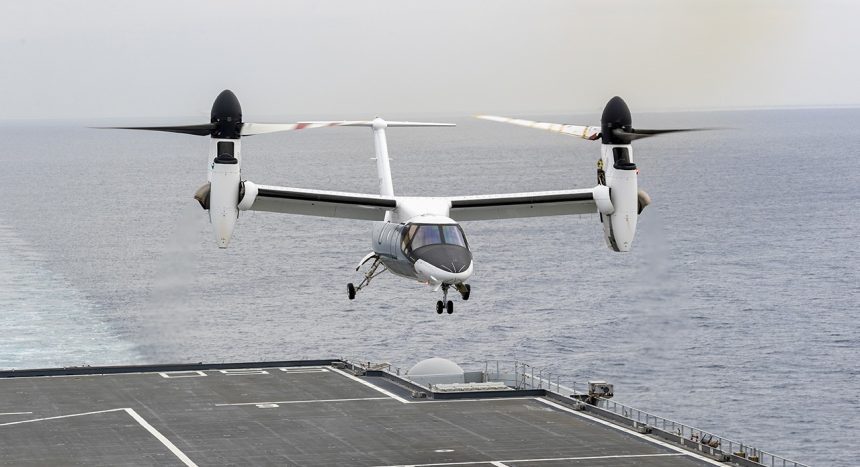The AW609 completed the first shipboard trials with the support of the Italian Navy.
From April 3 to April 12, 2024, the AW609 AC4 aircraft, representing the final production configuration of the Italian tilt-rotor, performed demonstration trials, relocating from Leonardo’s facility at Cascina Costa to Maristaer Grottaglie Naval Base, and then from the latter, to the Italian aircraft carrier ITS Cavour, sailing about 20 nautical miles offshore.
During the trials, the AW609, flown by Leonardo test pilots, showed its effective approach, stable deck landing and touchdown capabilities.
The demonstration provided a unique opportunity to further strengthen the awareness of the outstanding capablities of Leonardo’s tiltrotor in a maritime environment.
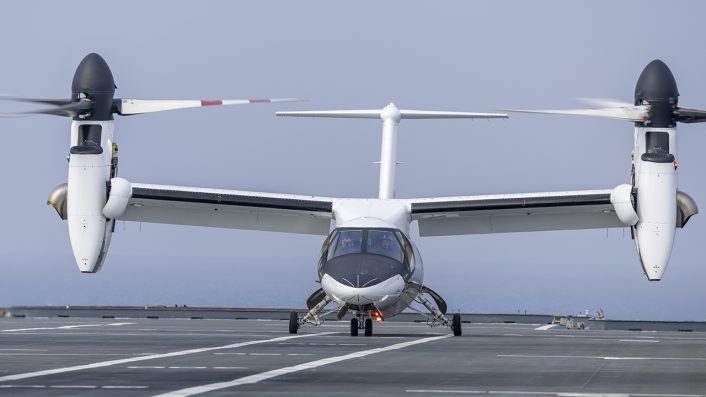
AW609
The AW609 was born as the BA609, a collaboration between Bell and Agusta, making its first flight in 2003 as the inaugural civilian tiltrotor aircraft. After Bell exited the project, Agusta, now Leonardo Helicopters, continued its development, aiming for a market introduction in the mid-2020s.
The tiltrotor leverages the benefits of both helicopters and fixed-wing aircraft. Its proprotor nacelles can tilt vertically for helicopter mode and rotate forward for fixed-wing mode in about 40 seconds. This conversion smoothly transfers lift from rotors to wings, managed by onboard computers within an optimal “conversion corridor.”
The AW609 features a fully composite airframe with a take-off weight of approximately 8 tonnes. It is equipped with two Pratt & Whitney PT6C-67A engines, enabling speeds over 275 knots and altitudes up to 25,000 feet. It boasts a maximum range of 1000 nm, extendable with auxiliary tanks, and can carry up to nine passengers plus pilot and co-pilot. Designed for known icing conditions, it meets top FAA standards for both fixed-wing aircraft and helicopters. Redundant systems, including a triple digital fly-by-wire flight control system, ensure reliability. The cockpit includes advanced Collins Aerospace Fusion avionics with three NVG-compatible touchscreens.
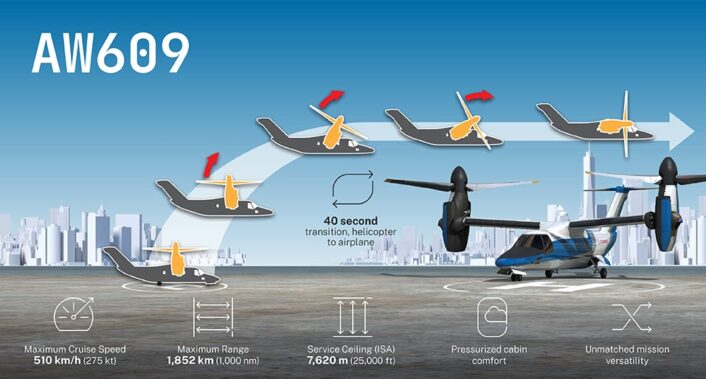
Leonardo is currently creating different configurations for the AW609 tiltrotor to suit various missions. Its unique performance characteristics make it ideal for passenger transport, offshore support for the energy sector, patrol and surveillance, search and rescue (SAR), medical transport, disaster relief, special operations, and government tasks.
In critical situations, the tiltrotor’s capabilities significantly enhance response times and coverage for SAR and Emergency Medical Services (EMS) missions. The AW609’s spacious cabin door and 600 lb hoist can accommodate a rescue basket, while two stretchers can be loaded for patients, allowing up to four medics to provide uninterrupted care.
Although initially designed for commercial use, the AW609 is also being developed for military missions where quick intervention and the ability to operate in confined spaces are essential. The primary military applications being explored include Homeland Security, VIP transport, Utility, Special Operations, and Personnel Recovery.
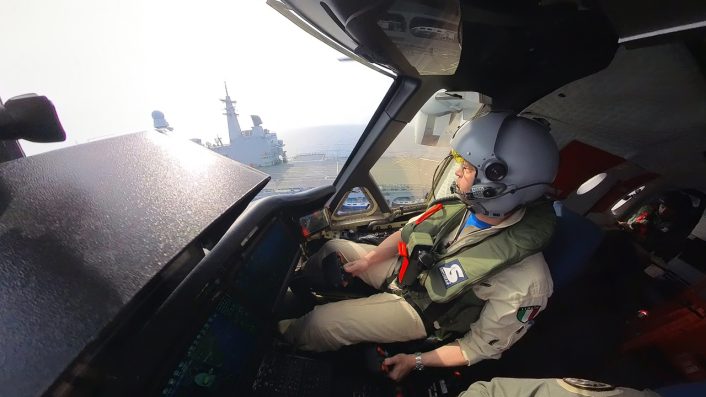
The AW609’s capability to operate over 500 km offshore extends its suitability to maritime and border patrol, long-range surveillance, anti-piracy, national waters protection, fisheries control, and long-range maritime SAR. Its speed and range allow these diverse missions to be conducted by a single aircraft type. This eliminates the need for multiple aircraft, both fixed-wing and rotary, to reach and perform in the rescue area promptly.
In that respect, the test aboard Cavour validate the AW609’s capability to launch missions from a naval asset. At the same time, the recent trials highlight the Italian Navy’s interest in acquiring tiltrotors (something that has been discussed for decades, with the service said to be pitched/interested in the V-22 Osprey), focusing particularly on ship-to-shore logistics capabilities.
Test Preparation Phase
The preparation of the live test phase was initially carried out with the support of an advanced simulator of the AW609 located at Cascina Costa. This kind of approach permitted a preliminary assessment of the activities and maneuvers, which were later performed in the “live test” operation. As declared, deck landing and take off procedures were performed in over 15 different conditions (including windy scenarios), featuring straight-in and lateral approach, vertical landing, vertical takeoff, and lateral exit.
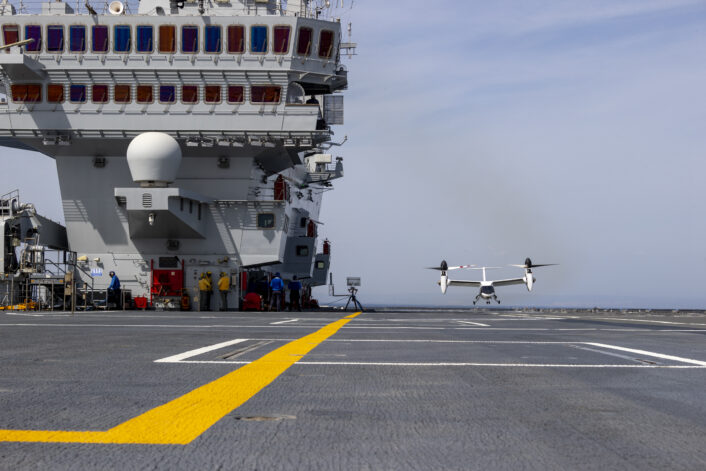
The demonstration trials are the latest step undertaken by a joint working group established in 2022, including Leonardo, the Italian Navy, Italian Army and Guardia di Finanza (Italy’s Customs police). The work is intended to evaluate the potential of tiltrotor technology. It provides a fast long range capability with vertical take-off and landing and a fast cruise, above the weather thanks to the pressurized cabin and high altitude performance.
Lorenzo Mariani, Co-General Manager of Leonardo, said in an official release: “Fast rotorcraft technologies continue to be core to our forward-looking capability development and value-proposition in the vertical lift domain, which has been extensively demonstrated by the progress on the AW609 tiltrotor programme.”
“The recent ship trials in Italy, with the strong support of the Italian Navy, within the framework of the working group also joined by the Italian Army and Guardia di Finanza, represent an important step towards the development of government applications as we reinforce our position to lead tiltrotor-based initiatives internationally and to meet future emerging requirements.”
Gian Piero Cutillo, Managing Director of Leonardo Helicopters, added: “The success of these trials set a major capability demonstration milestone to show the unique advantages of tiltrotors, and particularly that of the AW609, through a combination of high performance and versatility, which remains unmatched in the vertical flight sector. This experience provides an important opportunity to appreciate benefits that can truly revolutionize a range of missions or even open new operational possibilities. We thank all of our partners involved in this demonstration and for the studies undertaken, we look forward to moving to the next stages of evaluation.”
Following the initial ship trials campaign, Leonardo will conduct a detailed evaluation and analysis of the collected data. This will enable follow-on trials to refine approaches and drive further platform enhancements for optimal operation in the naval/embarked environment.

